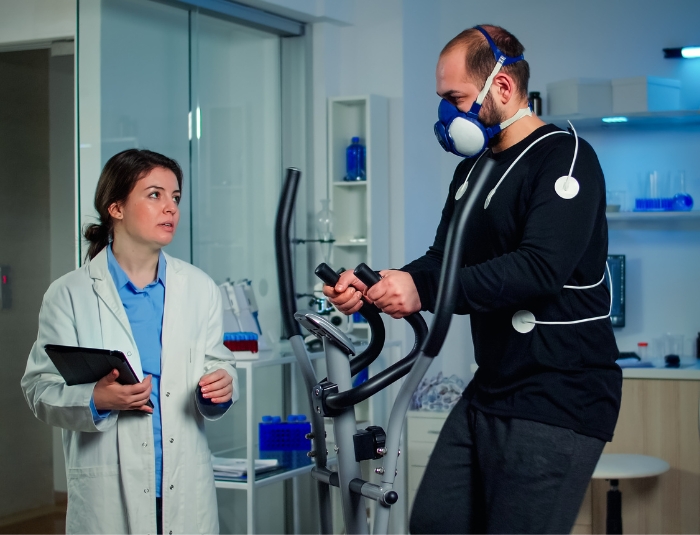V02 max – Why your Cardiologist recommends testing it

Longevity is today’s health buzzword. ‘Outlive’ is a best-selling book by Peter Attia that comes up in conversation with my patients and his comments on cardiac longevity are often quoted in my clinic. "No other intervention does nearly as much to prolong our lifespan and preserve our cognitive and physical function as exercise and maximizing your VO2 max is a key component of that." So what is VO₂ max
VO₂ max., short for "maximal oxygen uptake," represents the maximum amount of oxygen your body can utilize during intense exercise. It is recognized as the gold standard for assessing cardiovascular fitness and endurance.
Elite and endurance athletes are all too aware of their VO₂ max. It is a crucial indicator of heart health, overall fitness, and even lifespan. Research consistently shows that individuals with higher VO₂ max scores tend to live longer, healthier lives. A high VO₂ max signifies a strong heart, efficient lungs, and an optimal circulatory system, all working together to deliver oxygen to the muscles and organs.
Conversely, a low VO₂ max can indicate poor cardiovascular health, increased risk of heart disease, diabetes, and premature death. In fact, studies have found that VO₂ max is one of the strongest predictors of mortality, often more significant than traditional risk factors like cholesterol levels or blood pressure.
How is VO₂ Max Tested?
VO₂ max is typically measured through a graded exercise test performed in a controlled setting, such as a specialist clinic, sports science lab or specialized fitness facility. The test is conducted on a treadmill or stationary bike while the individual wears a mask connected to a metabolic analyzer. The peak amount of oxygen you consume, typically close to the point at which you “fail,” meaning the point where you just can’t keep going, yields your VO2 max.
What Happens During a VO₂ Max Test?
- Progressive Intensity :The individual starts at a low-intensity pace, which gradually increases in difficulty.
- Respiratory Analysis :The mask collects data on oxygen consumption and carbon dioxide output.
- Heart Rate Monitoring : A heart rate monitor tracks cardiovascular response.
- Peak Effort : The test continues until the subject reaches exhaustion or a plateau in oxygen consumption, despite increasing intensity.
The final score is reported in milliliters of oxygen per kilogram of body weight per minute (ml/kg/min). Higher scores indicate superior cardiovascular fitness. Direct measurement is the most accurate but many modern smartwatches and fitness trackers also offer VO₂ max estimations based on heart rate and activity data.
The Link Between VO₂ Max and Longevity
Published data consistently report on the link between VO₂ max and longevity. Individuals with low VO₂ max are at a significantly higher risk of cardiovascular disease and early mortality. Increasing VO₂ max through regular exercise can reduce the risk of all-cause mortality by up to 50%. Maintaining a high VO₂ max into older age is linked to greater independence, cognitive function, and overall quality of life. VO₂ max varies by age, gender, and fitness level. Below is a general guide for age-adjusted VO₂ max values (measured in ml/kg/min) based on fitness categories from the American College of Sports Medicine.
VO₂ Max Ranges (ml/kg/min) by Age & Fitness Level
Men
| Age | Excellent | Good | Average | Fair | Poor |
|---|---|---|---|---|---|
| 20-29 | >55 | 45-54 | 37-44 | 30-36 | <30 |
| 30-39 | >51 | 41-50 | 34-40 | 27-33 | <27 |
| 40-49 | >48 | 38-47 | 31-37 | 24-30 | <24 |
| 50-59 | >45 | 35-44 | 27-34 | 21-26 | <21 |
| 60+ | >42 | 32-41 | 25-31 | 20-24 | <20 |
Women
| Age | Excellent | Good | Average | Fair | Poor |
|---|---|---|---|---|---|
| 20-29 | >49 | 40-48 | 32-39 | 26-31 | <26 |
| 30-39 | >46 | 37-45 | 30-36 | 24-29 | <24 |
| 40-49 | >43 | 34-42 | 27-33 | 21-26 | <21 |
| 50-59 | >41 | 31-40 | 24-30 | 18-23 | <18 |
| 60+ | >38 | 28-37 | 22-27 | 16-21 | <16 |
VO₂ max can improved with consistent training and lifestyle changes, especially reducing sedentary habits. The most effective methods include:
- High-Intensity Interval Training (HIIT) – Alternating short bursts of intense effort with recovery periods boosts VO₂ max efficiently.
- Endurance Training – Activities like running, cycling, and swimming improve cardiovascular efficiency.
- Strength Training – While not as direct as aerobic exercise, resistance training supports heart health.
Whether you're an athlete seeking peak performance, someone looking to improve heart health, or simply aiming for a longer life, VO₂ max is a significant metric you should know. If you want to assess your fitness level and have a more prescriptive guide to exercising - consider getting your VO₂ max tested at The Harley Street Heart and Vascular Clinic, located at Gleneagles Hospital.

